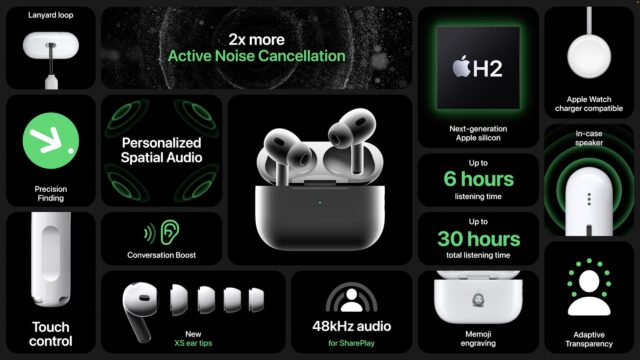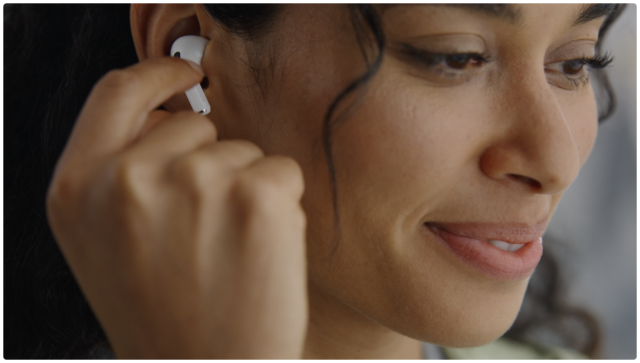Second-Generation AirPods Pro Add H2 Chip, Touch Control, Enhanced Case
The AirPods Pro earbuds have been well-reviewed and highly successful, so if you’re Apple, where do you go for the second generation? At its Far Out event, Apple unveiled an update to the AirPods Pro that keeps the basics the same while improving the audio performance, adding the new Touch control interaction mechanism, and revamping the charging case.
Apple built a new H2 chip into the second-generation AirPods Pro to give the earbuds additional audio processing capabilities. When coupled with a new low-distortion audio driver and custom amplifier, the H2 chip provides an even better audio experience. Aiding in the audio improvement is a new extra small ear tip that helps the AirPods Pro fit securely in more people’s ears.
The H2 chip enhances two other core AirPods Pro features. Apple says that the Active Noise Cancellation capability now cancels up to twice as much ambient noise, and the new Adaptive Transparency mode allows external sounds in through the passive ear canal seal while reducing more of the noise from harsh environmental sounds.
With iOS 16, you’ll be able to use Personalized Spatial Audio to customize your audio experience based on the size and shape of your head and ears. We’ll be curious to hear if users find it to be noticeably better.
Previously, you squeezed the stem of the first-generation AirPods Pro to control audio, with options for pause/play, skip forward or backward, and switching between noise cancellation and transparency mode. With the second-generation AirPods Pro, Apple has added Touch control, which lets you lightly swipe up or down on the stem to adjust the volume. You’ll continue to press the stem or use Siri for other actions.
Battery life has improved, with up to 6 hours of listening time with Active Noise Cancellation, an increase of 1.5 hours. The charging case provides four additional charges for a combined total of 30 hours of listening time, 6 hours more than the previous model. You can now charge the case from an Apple Watch charger, a MagSafe charger, a Qi charger, or a regular Lightning cable.
Beyond charging methods, the new case is sweat and water-resistant and includes a lanyard loop so you can more easily keep track of it. If you do misplace the case, you can find it more quickly thanks to support for Precision Finding in the Find My app when used with a U1-equipped iPhone. The case also features a built-in speaker to deliver louder tones when you’re looking for it. Finally, you can now personalize the case with a custom-posed Memoji, Animoji, and a curated list of stickers.
Pricing remains the same, with the second-generation AirPods Pro at $249. You can order starting 9 September 2022, and they’ll arrive starting 23 September 2022.


I’ve never used AirPods (or any other wireless earbuds, or Apple Music), and I see there’s a kerfuffle about whether the new ones “support Apple Lossless.” So I’m curious: is the DAC in the AirPod earpiece(s)?
All wireless earbuds and headphones have to have a DAC in them, because they receive audio as a digital signal in one of the codecs supported by Bluetooth (e.g. SBC, MP3, AAC, aptX). The earbud/headphone then has to decode what is essentially a streamed digital file into analogue sound waves to feed to the tiny speakers.
I know nothing about the relevant technical details of the AirPods Pro, but there are several issues that could prevent lossless audio support, such as:
Apple could choose to supplement Bluetooth with an alternative wireless protocol (either proprietary or an emerging standard) specifically for lossless audio support. Or they could drive a future version of Bluetooth to support this (I don’t follow its development, so maybe this has already happened?). So supporting lossless audio isn’t impossible, and they could already have the hardware needed in the new AirPods Pro but not ‘activate’ it yet. Will be interesting to see (aside from any debate on the practical benefits of lossless audio in a device such as the AirPods Pro!).
Thanks for a very clear and comprehensive explanation, Jolin.
Bluetooth is the bottleneck then, and any connection using it is subject to the limitations of the BT Codec. I suppose this must apply to the entire AirPod line, including the Max. What I can’t test because I don’t own any is whether my lossless files are playable by AirPods in any form, e.g. whether the iPhone is able to re-encode them to AAC before sending them out over Bluetooth (see also below). Has anyone tried it?
And it also means, presumably, that less limited (wired, WiFi) connections do (or can) support lossless. And that, in turn, [boredom alert!] leaves me wondering where the DAC(s) involved are located, where the conversion from lossless to analog occurs or even, in some cases, whether some additional digital re-encoding & decoding is taking place.
The simplest case, I guess, is when the lossless files on the hard disk attached my Mini are sent by Apple Music to my Marantz receiver over wifi (to a 3rd generation Apple TV connected by an HDMI cable to the receiver) and get converted there.
My iPhone 12 apparently has its own DAC–I can listen to lossless files stored on it on its tiny speaker if I want. But the 'pods that came with it use a digital (Lightning) connection, so they must have a DAC somewhere (connector? earbud?) upstream of the iPhone, and the head unit in my Honda must have one that it uses to covert the data streamed to it when the iPhone’s plugged into its USB port. So I guess the iPhone has a way of either (1) bypassing its own DAC when it detects a non-BT connection or (2) re-encoding the lossless files as AAC before sending them on. I wonder which?
But I’m just wondering. None of this processing cleverness is likely to be detectable by anyone listening to EarPods, AirPods or a car stereo except, possibly, to someone owning a pair of AirPods Max. It may even improve the experience for all I know: Tom Holman is a wonderful engineer, and there’s an enormous amount of other stuff (like Adaptive EQ, just to start with) going on in those tiny spaces.
All I ask is to be able to bypass it all when I’m listening to a non-Apple system.
I was most impressed by the lanyard loop.
And the Apple Watch charger compatibility.
I’ll probably never own this, so hopefully these features will make their way down to the normal AirPods. Yay, new Apple.
There are now two versions of AirPods 3d Gen. Hadn’t seen that reported. Buy AirPods (3rd generation) with MagSafe Charging Case - Apple
I see no reason to update my APPro right now, but it’s good to know that when they no longer hold a decent charge, the 2nd gen APPro should be a solid upgrade. Of course, I do hope the case goes USB-C before I need to get them.
I think Apple missed a marketing opportunity here though. They should have had Apple-branded lanyards ready to go now that the case comes with a loop. Obviously, not a single lanyard would be included with the new $249 APPro. Instead offer a single lanyard (from a selection of 7 colors that change every 4 months) as an add-on. For $39 of course. Make it $49 a pop if purchased separately. We think you’ll love it.
Does anyone know if third-party ear tips for the Airpods Pro v1 will fit the Airpods Pro v2?
Given that hearing aides will no longer be subscription only starting this October, has there been any discussion of providing the user with greater control over the contour of the frequency range? There is some basic augmentation available now however I am talking about something more specific.
Paul
Good question, Paul. I imagine a hearing aid feature is inevitable for the 'pods sooner or later. Among other things it’ll mean being able to disable Adaptive EQ, something I don’t think you can do at the moment. Come to think of it, I wonder whether AEQ plays nice with mild hearing loss at specific frequencies now?